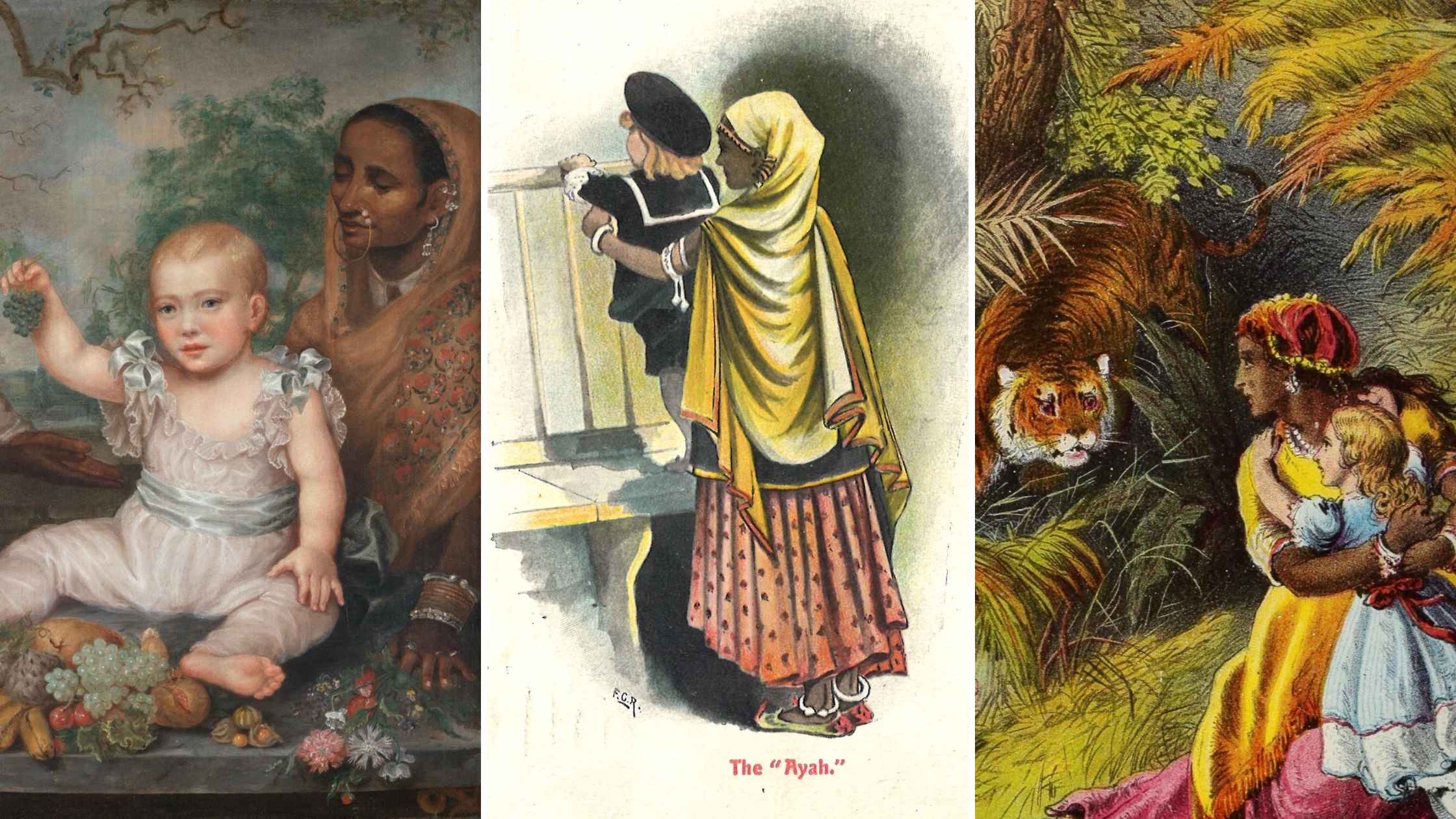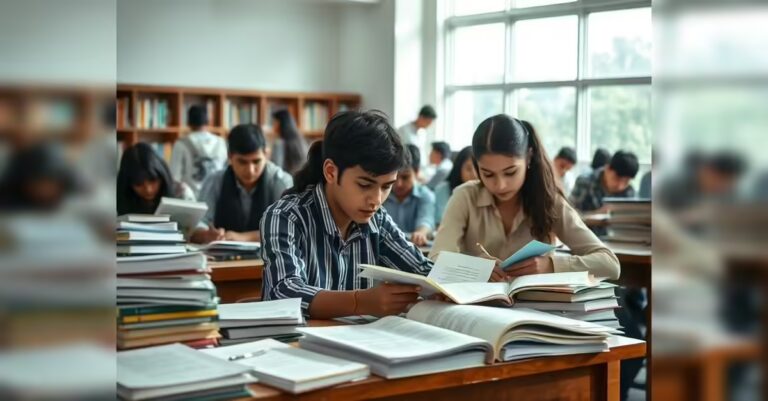
Female domestic labor has remained largely invisible in British Empire history. Yet, the ayah, the Indian caregiver to British families, was a hyper-visible figure in British imperial visual art. Ayahs appeared in a diverse range of images – from European oil-portraits to South Asian Company-style paintings commissioned by the British, to illustrations in children’s books, and later photographs and postcards.
This visual essay is a curation of some of these colonial representations of Indian ayahs, from the late-1700s to the early-1900s.
Majority of these colonial visuals sentimentalize the Indian ayah’s bond with the British family. Despite the visual veneration of the ayah, colonial visuals, this essay argues, served as tools of empire. Colonial art naturalized the care-labor of brown women for white families, even while romanticizing the ayah-child bond. Artists used certain visual conventions that were common at the time for depicting black and brown colonial subjects. The idealized images of ayahs, as this essay shows, ultimately upheld British colonial hierarchies of race, class, and empire.
The Indian Ayah during Company rule, late 1700s and early-1800s:
The British East India Company fought wars and acquired large parts of South Asia in the late-1700s and early-1800s. Company officers often commissioned European artists to paint their Indian ayahs as souvenirs of their life in India.
In 1792, William Wood painted an oil portrait of an Indian ayah. The inscription on the top right of the painting states: “Joanna de Silva, a native of Bengal, the faithful and affectionate Nurse of the Children of Lieutenant Colonel Charles Deare”.
Joanna de Silva’s name, hairstyle, jewelry, and clothing suggest that she hailed from the Indo-Portuguese community. In fact, the word Ayah is a loanword from Portuguese to English. Some of the earliest ayahs, like Joanna de Silva, were Catholic women of mixed Indo-Portuguese descent. Hindu, Muslim, or converted-Christian ayahs of South Asian origin eventually replaced the Indo-Portuguese ayahs.
Joanna de Silva had sailed from Bengal to Britain taking care of the Deare children after their father’s death in 1790, in the Third Anglo-Mysore War, fought by the East India Company against Tipu Sultan. Wood had painted her in Britain.

Wood’s portrait of Joanna de Silva is quite unique. A standalone oil portrait of an ayah was highly unusual in the British colonial period. Moreover, the ayah’s name and identity – Joanna de Silva – inscribed on the top-right of her portrait – makes the painting rare and exceptional.
Indian ayahs remained anonymous despite their frequent depictions in British visual representations.
Indian ayahs mostly appeared in their care-giving role to British children and British women within imperial family portraits, as we will see below.
Joshua Reynolds, the famous British artist, created two of the earliest family portraits depicting Indian ayahs.
Reynolds was himself a shareholder in the East India Company, although he had never been to India. In 1759, Edward Cruttenden, a director of the East India Company, commissioned Reynolds to paint his three Indian children with their Indian ayah, who had accompanied them to Britain after they lost their mother in the infamous Black Hole of Calcutta.

In 1765, Reynolds painted another ayah in a portrait of either George Clive’s family or Tysoe Hancock’s family. This ayah had also sailed to Britain with her employers.

In European family portraits, servants were typically erased or painted on the margins – so that they would not be confused with family members or upset class hierarchies. Reynolds, however, depicted both ayahs conspicuously at the center of the canvas. Far from threatening class hierarchies, Indian ayahs in British family portraits became “Oriental ornamentation”, enhancing the class status of the British family. Indian ayahs served the same purpose as other colonial commodities such as Chinese porcelain, Persian carpets, or Burmese teak. They emphasized the British family’s imperial identity, affluence, and taste for the “exotic”.
While British families no doubt wished to memorialize their beloved Indian caregivers, the paintings were also a testament to colonial hierarchies.
If we look closely, we find that the Cruttenden daughters, and the wife and daughter in the Clive/Hancock painting confidently return the gaze of the viewer. By contrast, both paintings depict the ayahs with downcast eyes to indicate their servility. In the Clive/Hancock portrait, the ayah’s depiction in a kneeling-down position, further indicates her subservience to the British family, and by extension, India’s subservience to Britain.
In the 1780s, the Governor-General of Bengal, Warren Hastings commissioned the famous European painter Johan Zoffany to paint himself and his wife Marianne (who was leaving for Britain) along with her ayah on the grounds of their Alipore mansion.
British imperial family portraits were usually commissioned just before or just after the family’s return home to Britain, suggesting that the ayah’s presence served as a nostalgic memorabilia of British imperial life.

The ayah wears a fine muslin shawl, golden-nagra shoes, and strands of pearls similar to Mrs. Hastings’, whose bonnet she holds. Although it is unlikely that ayahs possessed or wore expensive jewelry while working, the Clive/Hancock ayah and Joanna de Silva all wear elaborate gold ornaments on their hair, neck and arms. At a time when East India Company administrators like Clive and Hastings attracted criticism for their corruption and exploitation in India, the bodies of Indian ayahs decked in pearl and gold ornaments became canvases for their employers to showcase their benevolence and paternalism towards colonial subjects.
Elijah Impey, Chief Justice of the Calcutta Supreme Court, and a friend of Hastings, also commissioned Zoffany to paint a conversation piece of his family in India in the 1780s.
In the portrait, a band of strolling musicians entertain Lady Impey, seated on a European-style chair. In contrast to her Britishness, two bare-foot sari-clad bejeweled Indian ayahs sit on the floor, taking care of the youngest Impey child.

The bodies of Indian ayahs became a foil to highlight the whiteness and racial purity of British women and children in the age of British moral shame about inter-racial relations and mixed-race children in the empire. The brownness of the Clive/Hancock family’s ayah, as well as Mrs. Hasting’s ayah, emphasized the whiteness and race/class purity of the British memsahib.
Artists also constructed race and class hierarchies in British family portraits through chiaroscuro techniques.
The painter Thomas Hickey was especially adept at making light stream in from an unknown source to illuminate the whiteness and implied race/class purity of the British child. By contrast, the dark ayah was deliberately placed in the shadows to obscure and further racialize her body.


While the identity of the subjects of Hickey’s second portrait (Young boy and his Ayah) is unknown, the first portrait was commissioned by Stephen Sullivan, one of the Directors of the Company. It shows his son Lawrence playing with his silk-sari-clad Indian ayah. Both paintings construct colonial racial hierarchies through the play of light and shadow.
Race and class hierarchies were also produced in British imperial family portraits through the deliberate positioning of Indian ayahs lower than the British subjects.
We see this in Thomas Hickey’s 1798 painting of the christening party of a British child in Madras. The ayah kneels down so that her head appears lower than that of the British men and women, and even lower than the British baby whom she holds.


Similarly, in George Duncan Beechey’s painting of a British woman and her children, the Indian ayah in a red-bordered-white-sari stands below the stairs. She appears as a diminutive figure, behind and below the British children she looks after, which implies her racial inferiority and servility.
Other painters such as Sarah Baxter and John Thomas Seton followed the European artistic convention of making servants blend with the background and tropical foliage in order to highlight the British subjects.
Baxter’s painting is particularly interesting as she was one of the rare female painters of the time, and she painted her own son with his ayah and bearer.


Sir John Hadley D’Oyly commissioned Seton to paint his ailing wife Diana and their two children with their Indian ayah. The ayah blends with the dark background, indicating her marginal position to the family. The child standing and leaning against his mother’s lap is most likely Charles D’Oyly, who would have been around four in 1785, when this family portrait was painted.
Charles D’Oyly would grow up to be an Opium Agent for the East India Company, as well as a prolific watercolor painter of colonial life, with his own lithographic press. In two of D’Oyly’s paintings, we find his replication of Seton’s usage of his childhood ayah as a foil. D’Oyly used chiaroscuro techniques to racialize the dark-skinned Indian ayah and reinforce the whiteness of the British subjects.


Paintings of ayahs with British families thus visually reinforced colonial power hierarchies. The ayah’s dark-skin color and subservient position highlighted the whiteness, racial purity and class-status of British imperial family.
European painters used a special pigment called “Indian yellow” to paint the yellowish-brown skin of ayahs and other South Asians. This pigment, like indigo (used to paint tropical landscape), was produced through colonial South Asian labor. Race was thus materially inscribed in the paintings of Indian ayahs.
The Indian Ayah during the 1857 Indian Rebellion:
During the 1857 Rebellion (which the British designated as a Mutiny), the ayah’s love and loyalty became legendary in British imperial imagination. The Rebellion finally brought an end to the Company’s rule, and the Indian Empire passed into the hands of the British Crown.
In 1858, Joseph Paton produced a commemorative painting, depicting an Indian ayah hiding with a group of distressed British women and children, while a group of Indian rebel-sepoys burst into their hideout.
The implication of sexual assault on the British women by Indian men caused such an outrage that Paton eventually replaced the Indian sepoys with valiant Scottish Highlanders coming to rescue the women.

In another 1858 painting by Abraham Solomon, we see a faithful Indian ayah carrying an English child and escaping with the British residents from Mutiny-hit Lucknow.

Neither Paton nor Solomon had ever been to India. Yet they contributed to the visual construction of the trope of the faithful Indian ayah who identified more with the British family rather than her own community at this moment of violence. Despite glorifying the ayah’s fidelity, Solomon racialized the dark ayah by strategically placing her in the tree’s shadow while moonbeams illuminate the British women and children, highlighting their whiteness.
The ‘Indian ayah – British child’ dyad came to be greatly sentimentalized in the post-1857 decades.
Several artists painted young British children lovingly nestled in the laps of their Indian ayahs. In 1865, Alexander Grant, the Inspector of Schools in Madras, commissioned an oil painting of his infant son on the lap of his ayah.

In 1866, George Reid commissioned a portrait of his daughter Edith in the arms of an Indian ayah who had accompanied them to New Zealand. While Edith returns the viewer’s gaze, the ayah looks away.

In 1879, Emma Fullerton painted an ayah carrying a British child while another child sleeps behind her. Unlike the bucolic setting of the 1865 and 1866 paintings, Fullerton’s painting is set inside the ayah’s hut (with wicker stools, clay and brass pots).

A discretely positioned gun stands against the left wall hinting at an 1857-setting. The ayah has hidden the British children from the rebels; perhaps a reflection of Fullerton’s own childhood in India? The ayah’s affection for British children in these paintings naturalized her inherently caring disposition. Again, the Ayah’s downcast or averted eyes visually indicate her subservience to the British family, even as the love of the brown ayah for the white child was sentimentalized.
In the late-colonial period, the ayah became a stock character in British children’s fictions set in India.
The typical plot of these fictional stories centered around devoted ayahs risking their lives to save British children (lost in the jungles) from ferocious tropical beasts. Colorful illustrations in these books strengthened the stereotype of the faithful ayah for young British readers, even those who had never been to the empire. In Edith and her Ayah (1873), for instance, the ayah is ready to give up her life for Edith when a Bengal tiger attacks.

Similarly, in The Jungle Baby (1900), the ayah picks up the British boy and runs to safety when a poisonous snake comes to the garden. Playing on British fantasies of the “Orient”, the “tropics”, and the “faithful ayah”, The Jungle Baby opens as follows: “There was once a little baby boy called Bab-ba, he had bright blue eyes and golden curls, and he had Ayah for his nurse. She had been with Bab-ba ever since he was quite a tiny baby in long robes, and she was very fond of him. Her name was Jeejee-walla, but they just called her Ayah.”

The Indian ayah in “Company paintings” by South Asian artists:
British families not only commissioned European painters but also deployed South Asian painters to paint British imperial domestic life with ayahs. Artists trained in Mughal-style paintings (previously called miniatures) were losing patronage in the regional courts with the ascendancy of the East India Company. These Indian artists looked for commissions from Company officers, creating a hybrid art-style (Company kalam) combining Mughal and Rajput influence with Western perspectives to suit their British clientele.
Back in the 1780s, the Impeys, who had commissioned Zoffany to paint their family in Calcutta, had also commissioned the Patna-painter Shaikh Zain-ud-din to paint the Impey children tended by five Indian ayahs inside the imperial nursery.

In 1846, John Spencer Login, Resident surgeon in Lucknow, and later the guardian of Duleep Singh of Punjab, commissioned an Awadhi artist to paint his three children in the nursery with their Indian ayah and their Indian playmate, perhaps the ayah’s child?

Not all imperial Britons could afford to commission paintings of their own families and servants. Indian painters, meanwhile, produced sets of paintings on mica or paper, depicting Indian servants working in British households, particularly the ayah holding a British child. The gold nagra shoes of the ayahs in the Murshidabad paintings particularly stand out, as do the heavy jewelry. Richly adorned ayahs probably had a better market among British buyers, as they testified to the well-treatment of brown maidservants in British homes.

These affordable, hybrid stylized paintings had ethnographic and exotic value for British collectors. It allowed them to take back to Britain more “authentic” souvenirs of Indian servants painted by Indian artists themselves.
Ayahs in Colonial Photographs and Postcards, early-1900s:
The arrival of photography in the late-1800s provided a new medium for the visual representation of ayahs. Instead of commissioning paintings, British families in India now commissioned studio-photographs of their children tended to by ayahs.
Although deemed more “authentic” than paintings, photographs of British families with their Indian ayahs were mostly “staged”. Hand-tinting the black and white photos (often by local painters) allowed them to be imbued with the Imperialist and Orientalist expectations of British clients.
The early-1900s was the “Golden Age of Postcards”. The hand-tinted photos of ayahs were sometimes turned into postcards. Some of these women also posed in other roles, suggesting they were not ayahs at all, but professional photographic models.
Postcards reproduced the racialization, idealization, maternalization, and exoticization of ayahs from earlier oil portraits.
Only wealthy British families could commission family portraits and photographs. But mass-produced postcards provided a cheap means to ordinary British people to collect images of the Indian ayah and experience imperial pride and racial belonging in the heyday of the British Empire. The ayahs in postcards also stood as representatives of Indian women for Britons who had never been to India.


Postcard publishers not only used photographs of ayahs but also commissioned illustrations of ayahs to British artists as well as Indian artists (such as M.V. Dhurandhar – see below).

Despite the hypervisibility of the ayah in British imperial visual art from the late-1700s to the early-1900s, these images tell us little to nothing about the lives and experiences of Indian ayahs as they toiled in the British imperial home.
Historians have unearthed painful stories of ayahs facing abuse and abandonment by British employers, from legal archives. The visual archive of ayahs completely erases those life-stories. These visuals however tell us a lot about British cultural attitudes towards colonial subjects, particularly colonial women who provided domestic labor. They demonstrate how British employers and painters reinforced Eurocentric and Orientalist stereotypes about Indian ayahs. The early colonial oil portraits of ayahs, set a visual template of race, class, and gender, further perpetuated by photographs and postcards in the late-colonial period. Despite the visual veneration of the ayah and romanticization of the ayah-child bond, the images, as this essay shows, acted in the service of empire. The sentimental images of ayahs ultimately upheld British colonial hierarchies and naturalized the care-labor of brown women for white families.
This essay was commissioned for the exhibition, ‘Women’s Work/Worth’ – hosted by The Heritage Lab in collaboration with King’s College London as part of the research project ‘Laws of Social Reproduction’. A version of this essay was presented by the author at the “Capturing India” panel hosted by the India Foundation of Arts and Victoria Memorial Hall in June 2022.
Satya Shikha Chakraborty is Assistant Professor of History at The College of New Jersey. For more on the history of ayahs, see the author’s award-winning book Colonial Caregivers: Ayahs and the Gendered History of Race and Caste in British India (Cambridge University Press, 2025).








